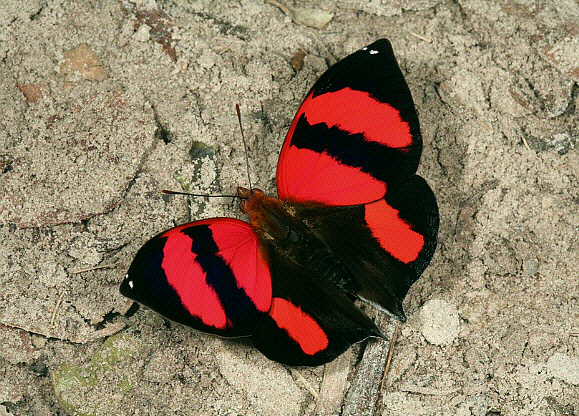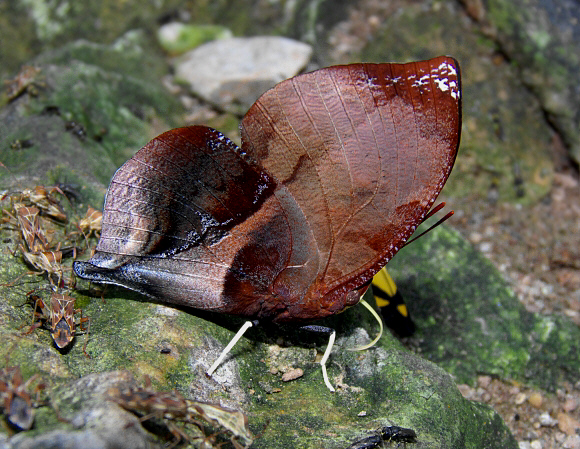 Siderone galanthis, Rio Cristalino, Mato Grosso, Brazil – Tony Hoare
Siderone galanthis, Rio Cristalino, Mato Grosso, Brazil – Tony Hoare
Introduction
The tribe Anaeini comprises of 87 neotropical species in the genera Coenophlebia, Anaea, Consul, Memphis, Polygrapha, Siderone, Fountainea and Zaretis. The butterflies are characterised by having a very rapid and strong flight. They have stout bodies, falcate wings, and on the upper surface are generally black, marked with bands of orange, bright red, or lustrous blue according to genus and species. The undersides of all Anaeini are cryptically patterned in mottled brown tones, and bear a very strong resemblance to dead leaves.
There are only 2 known species in the genus Siderone, namely syntyche and galanthis. Both are black on the upperside, with bright scarlet markings. The outer scarlet band is absent in syntyche, which also has a smaller scarlet area at the base of the wings.
Siderone galanthis is distributed from Mexico to southern Brazil, and also occurs in the Caribbean on Cuba, the Dominican Republic, and Trinidad.
 Siderone galanthis, Satipo, Peru – Dave Griffiths
Siderone galanthis, Satipo, Peru – Dave Griffiths
Habitats
This species is found in deciduous and evergreen forests at altitudes between 0-900m.
Lifecycle
The eggs are smooth and white. They are laid singly on leaves of the larval foodplants Casearia and Zuelania ( Flacourtiaceae ). Small plants along forest edges are usually chosen for oviposition.
The fully grown larva is dark brown, marked along the back with suffused chevrons and blotches. It has a strange lip-shaped thoracic hump, and its head is adorned with a pair of thick knobbed horns. It constructs a “frass chain” – a structure made from silk threads and its own droppings – and rests upon this when not feeding.
The chrysalis is described by DeVries as being “green with dark areas near the spiracles and edges of wingpads”. It is squat in shape, with indented wingpads and compressed abdominal segments, and is suspended by a stout cremaster from a stem or leaf.
Adult behaviour
Males are usually found singly, imbibing mineralised moisture from the ground on forest tracks or at tapir licks, peccary wallows, dry river beds or other semi-shaded habitats. They tend to walk about on the ground fanning their wings, displaying the vivid scarlet bands on the upper wings. I have also seen them resting with wings half open on foliage and on tree trunks at a height of about 4 metres.
The bright red bands on the upperside probably also function as a form of flash-colouration. When seen in flight the butterfly is highly visible to birds, but if pursued it immediately lands and snaps its wings shut so that only the dead-leaf underside is visible. The bird still keeps searching for a bright red butterfly, but the “now you see me, now you don’t” alternation between the brilliant upperside and sombre underside confuses it, foiling its search pattern. This survival strategy however is not always effective – in Costa Rica e.g. I have on more than one occasion found detached wings of this species on the forest floor, where birds have eaten the body and discarded the wings.
